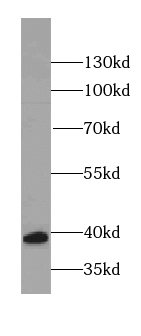Products
RBM4 antibody
| Size | Price |
|---|---|
| 100µg | Inquiry |
- SPECIFICATIONS
- FIGURES
- CONDITIONS
- FAQS
- Product Name
- RBM4 antibody
- Catalogue No.
- FNab07177
- Size
- 100μg
- Form
- liquid
- Purification
- Protein A+G purification
- Purity
- ≥95% as determined by SDS-PAGE
- Clonality
- monoclonal
- Isotype
- IgG1
- Clone ID
- 6F6
- Storage
- PBS with 0.02% sodium azide and 50% glycerol pH 7.3, -20℃ for 12 months(Avoid repeated freeze / thaw cycles.)
- Immunogen
- RNA binding motif protein 4
- Alternative Names
- RNA-binding protein 4|Lark homolog (hLark)|RNA-binding motif protein 4|RNA-binding motif protein 4a|RBM4|RBM4A antibody
- UniProt ID
- Q9BWF3
- Observed MW
- 40 kDa
- Tested Applications
- ELISA, WB, IHC, IF
- Recommended dilution
- WB: 1:500-1:2000; IHC: 1:20-1:200; IF: 1:50-1:500
 HeLa cells were subjected to SDS PAGE followed by western blot with FNab07177(RBM4 Antibody) at dilution of 1:1000
HeLa cells were subjected to SDS PAGE followed by western blot with FNab07177(RBM4 Antibody) at dilution of 1:1000
 Immunohistochemistry of paraffin-embedded human cervical cancer tissue slide using FNab07177(RBM4 Antibody) at dilution of 1:50
Immunohistochemistry of paraffin-embedded human cervical cancer tissue slide using FNab07177(RBM4 Antibody) at dilution of 1:50
- Background
- RNA-binding factor involved in multiple aspects of cellular processes like alternative splicing of pre-mRNA and translation regulation. Modulates alternative 5'-splice site and exon selection. Acts as a muscle cell differentiation-promoting factor. Activates exon skipping of the PTB pre-mRNA during muscle cell differentiation. Antagonizes the activity of the splicing factor PTBP1 to modulate muscle cell-specific exon selection of alpha tropomyosin. Binds to intronic pyrimidine-rich sequence of the TPM1 and MAPT pre-mRNAs. Required for the translational activation of PER1 mRNA in response to circadian clock. Binds directly to the 3'-UTR of the PER1 mRNA. Exerts a suppressive activity on Cap-dependent translation via binding to CU-rich responsive elements within the 3'UTR of mRNAs, a process increased under stress conditions or during myocytes differentiation. Recruits EIF4A1 to stimulate IRES-dependent translation initiation in respons to cellular stress. Associates to internal ribosome entry segment(IRES) in target mRNA species under stress conditions. Plays a role for miRNA-guided RNA cleavage and translation suppression by promoting association of AGO2-containing miRNPs with their cognate target mRNAs. Associates with miRNAs during muscle cell differentiation. Binds preferentially to 5'-CGCGCG[GCA]-3' motif in vitro.
How many times can antibodies be recycled?
First, usually it's not suggested to recycle antibodies. After use, buffer system of antibodies has changed. The storage condition of recycled antibodies for different customers also varies. Thus, the performance efficiency of recycled antibodies can’t be guaranteed. Besides, FineTest ever conducted the antibody recycling assay. Assay results show recycling times of different antibodies also varies. Usually, higher antibody titer allows more repeated use. Customers can determine based on experimental requirements.
Notes: After incubation, we recycle rest antibodies to centrifuge tube and store at 4℃. High titer antibodies can be stored for a minimum of one week. Reuse about three times.
What are components of FineTest antibody buffer?
Components of FineTest antibody buffer are usually PBS with proclin300 or sodium azide, BSA, 50% glycerol. Common preservative is proclin300 or sodium azide, which is widely applied in the lab and industry.
How about the storage temperature and duration of FineTest antibodies?
Most antibodies are stored at -20℃. Directly-labeled flow cytometry antibodies should be stored at 2 - 8℃. The shelf life is one year. If after sales issues for purchased antibodies appear, return or replacement is available. Usually, antibodies can be still used after the one-year warranty. We can offer technical support services.
Is dilution required for FineTest antibodies? What’s the dilute solution?
Directly-labeled flow cytometry antibodies are ready-to-use without dilution. Other antibodies are usually concentrated. Follow the dilution ratio suggested in the manual. Dilute solution for different experiments also varies. Common antibody dilution buffers are acceptable(e.g. PBST, TBST, antibody blocking buffer).
How to retrieve antibodies for immunohistochemistry?
Common retrieval buffers: Tris-EDTA Buffer(pH 9.0); Citrate Buffer(pH 6.0)
Heat induced antibody retrieval:
Method 1: Water-bath heating: Put the beaker with retrieval buffer and slide in the boiling water bath. Keep the boiling state for 15min. Naturally cool to room temperature;
Method 2: Microwave retrieval: Put the beaker with retrieval buffer and slide in the microwave oven. Heat at high power for 5min, Switch OFF for 3min, Heat at medium power for 5min. Naturally cool to room temperature.
How to choose secondary antibodies?
(1) Secondary antibodies react with primary antibodies. Thus, secondary antibodies should be against host species of primary antibodies. E.g. If the primary antibody is derived from rabbit, the relevant secondary antibody should be against rabbit. E.g. goat anti rabbit or donkey anti rabbit.
(2) Choose secondary antibody conjugates according to the experimental type, e.g. ELISA, WB, IHC etc. Common enzyme conjugated secondary antibodies are labelled by HRP, AP etc. Fluorescin or dye labelled secondary antibodies are applied in immunofluorescence and flow cytometry(e.g. FITC, Cy3).
